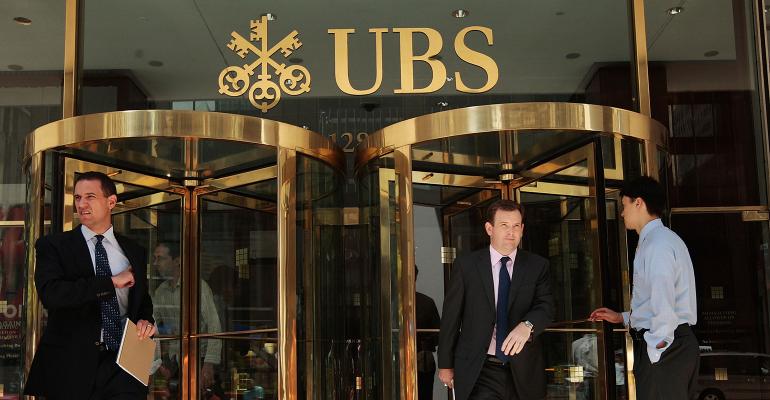By Neil Weinberg and Katherine Chiglinsky
(Bloomberg) --Has a 13-year truce in the brokerage world come to an end?
The rapid-fire exits of UBS Group AG and Morgan Stanley from a pact that grants financial advisers a free pass to hop jobs with client data in tow has rattled the industry, raising questions about whether the arrangement is about to unravel entirely.
The agreement, known as the Protocol for Broker Recruiting, is likely to survive -- if for no other reason than the lack of palatable alternatives, according to industry observers.
“My cynical view is that a lot of firms are saying ‘We’re not concentrating on recruiting’ and might get out,” said Dennis Concilla, an attorney who runs a website that tracks the agreement. “But the protocol may always be of some value to some people,” given the high cost of litigating over departures and the need for guardrails in handling sensitive client data, he says.

Doubts about the future of the protocol flared Monday when UBS announced its intention to withdraw from the pact. A month earlier, Morgan Stanley revealed similar plans. Both companies said membership no longer made sense at a time when they were focused on grooming advisers internally rather than on recruiting.
In announcing its withdrawal, Morgan Stanley added that the protocol had become “replete with opportunities for gamesmanship and loopholes,” with members “opportunistically” joining to make strategic hires and then dropping out.
The protocol was drafted by three big firms in 2004 at a time when companies were getting into trouble with regulators over their handling of client data and routinely seeking restraining orders from courts when advisers would leave and try to take clients with them, Concilla says.
“Judges would get fed up,” said Kevin Hoffman, an attorney who represents advisers and described appearing in the same courtroom to argue opposite sides of the poaching debate in different cases.
Just three pages in length, the protocol grants departing advisers a waiver from the non-solicitation agreements common in the industry. That enables job-hopping advisers to move their books of business with them, as long as they take only the five pieces of client information the protocol permits: names, addresses, phone numbers, email addresses and account titles.
Antitrust Concerns
While the protocol’s founders envisioned it as serving big firms, they couldn’t wall it off from others without risking running afoul of antitrust laws, industry attorneys said. Since then, membership has mushroomed to many hundreds of firms.
“They thought it would be an old-boys’ network of three or four houses,” Concilla says of the protocol’s founders. “They could never have dreamed it would attract 1,600 members.”
A significant chunk of the signatories were set up specifically to help advisers break away from wire houses under the protocol’s protections. They typically do so by getting someone to set up a registered investment-advisory firm that joins the protocol. The advisers then quit their jobs — often on a Friday — take control of the new firm and race to woo clients before their former employer can beat them to the punch.
The strategy has become so successful that $1 billion-plus breakaways are now a regular occurrence. The migration has resulted in independent RIAs steadily cutting into the wire houses’ market share, and the biggest players have started looking for ways to staunch the bleeding.
Limited Joinder
“The reaction is ‘We can’t really compete at the higher level for some of these teams that are breaking away so the only thing we can do is basically not play nicely when they leave,’” says Frank LaRosa, founder of Elite Consulting Partners.
Big firms have added their own flourishes. JPMorgan Chase & Co., for example, is one of about a dozen companies that has claimed a “limited joinder” to the protocol, saying advisers in parts of the bank won’t receive its protections when leaving while others are covered by the agreement.
For all its faults, the protocol continues to have backers, even among sizable firms. Raymond James Financial Inc., for example, has vowed to remain a member if it were “the last firm standing.”
While the protocol is undeniably fraying, and could collapse if a handful of the largest remaining members pull out, its saving grace may be the cost of letting it fail and the difficulty of forging an alternative.
The idea of a “protocol 2.0” has been bouncing around for some time, but getting hundreds of members with competing interests to agree on revisions would likely prove a daunting task. And a return to the pre-2004 legal wars could breed animosity and raise costs all around.
Another option would be for the Securities and Exchange Commission to clarify client privacy regulations to define what data departing advisers can take with them, rather than leaving it to the industry, said Brian Hamburger, founder of MarketCounsel, which helps advisers go independent.
“The only viable solution is for regulators to take note of the impact on clients” of barriers involving the movement of advisers, Hamburger said. “Once you lock up clients, or make it difficult to move with advisers, you’re hurting clients’ rights."
To contact the reporters on this story: Neil Weinberg in New York at [email protected] ;Katherine Chiglinsky in New York at [email protected] To contact the editors responsible for this story: Sara Forden at [email protected] Steven Crabill, Larry DiTore





